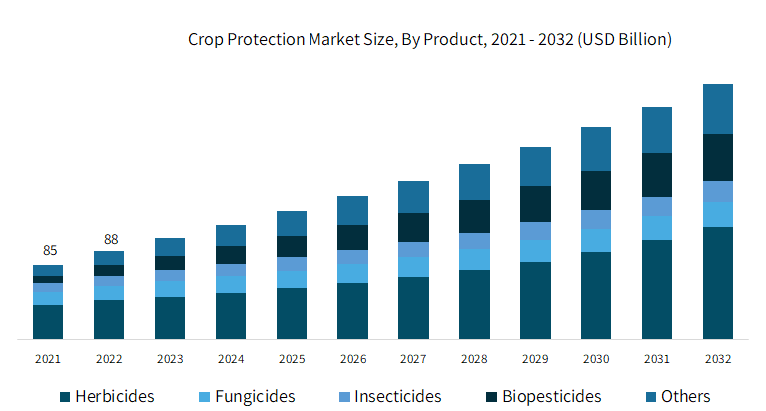Introduction
The Crop Protection Market plays a crucial role in ensuring agricultural productivity and food security by safeguarding crops from pests, diseases, and weeds. This article provides an in-depth analysis of the crop protection market, examining its key trends, challenges, and opportunities for growth.
Understanding Crop Protection
Crop protection encompasses a range of products and practices aimed at preserving crop health and optimizing yields. These include pesticides, herbicides, fungicides, insecticides, and biopesticides, as well as integrated pest management (IPM) techniques. Crop protection products are essential for sustaining global agricultural production and meeting the growing demand for food, feed, fiber, and bioenergy.
Crop Protection Market Overview
The crop protection market is a dynamic and diverse sector, comprising multinational corporations, regional players, and innovative startups. According to market research reports:
- The global crop protection market was valued at over USD 60 billion in 2020, with projections to surpass USD 75 billion by 2025. The market is expected to grow at a compound annual growth rate (CAGR) of approximately 3-4% during the forecast period, driven by increasing adoption of modern agricultural practices, expansion of arable land, and rising demand for high-quality crops.
- The market is segmented based on product type, crop type, application method, and region. Herbicides account for the largest market share, followed by insecticides and fungicides. Cereals and grains, fruits and vegetables, and oilseeds and pulses are the primary crop segments.
Key Trends in Crop Protection
Several trends are shaping the crop protection market landscape, including:
- Shift towards Biologicals: Growing consumer awareness and regulatory pressures are driving demand for biopesticides and biostimulants derived from natural sources. Biologicals offer effective pest and disease control while minimizing environmental impact and ensuring product safety.
- Digital Agriculture: The integration of digital technologies such as precision farming, data analytics, and remote sensing is revolutionizing crop protection practices. Smart sensors, drones, and satellite imagery enable farmers to monitor crops, detect pest outbreaks, and optimize pesticide applications with greater precision and efficiency.
- Sustainable Solutions: Sustainability is a key focus area for crop protection companies, with initiatives to reduce chemical inputs, promote eco-friendly alternatives, and support biodiversity conservation. Integrated pest management (IPM) approaches that combine biological, cultural, and chemical control methods are gaining traction as sustainable alternatives to conventional pesticide use.
Challenges Facing the Crop Protection Market
Despite its growth potential, the crop protection market faces several challenges, including:
- Regulatory Hurdles: Stringent regulations governing pesticide registration, approval, and usage pose compliance challenges for manufacturers and farmers. Regulatory requirements vary by country and region, adding complexity and costs to product development and market access.
- Resistance Management: Prolonged use of chemical pesticides has led to the emergence of pesticide-resistant pests and weeds, diminishing the efficacy of existing control measures. Addressing resistance requires innovative solutions such as new active ingredients, novel formulations, and rotation strategies to preserve efficacy and prolong product lifespan.
- Public Perception: Negative perceptions surrounding pesticide use, environmental impacts, and food safety concerns pose reputational risks for crop protection companies. Public education, transparency, and engagement are essential for building trust, addressing misconceptions, and promoting responsible pesticide stewardship.

Opportunities for Growth and Innovation
Despite the challenges, the Crop Protection Market offers significant opportunities for innovation and growth:
- Technological Advancements: Continued investment in research and development (R&D) is driving innovation in crop protection, leading to the development of safer, more effective, and environmentally sustainable products. Nanotechnology, gene editing, and biotechnology hold promise for next-generation crop protection solutions.
- Market Expansion: Emerging markets in Asia-Pacific, Latin America, and Africa present untapped opportunities for market expansion, driven by population growth, urbanization, and changing dietary preferences. Strategic partnerships, distribution networks, and tailored product offerings are essential for capturing market share in these regions.
- Collaborative Partnerships: Collaboration between industry stakeholders, research institutions, governments, and non-governmental organizations (NGOs) is critical for addressing shared challenges and advancing sustainable agriculture. Public-private partnerships, knowledge sharing, and technology transfer initiatives can accelerate innovation and promote responsible crop protection practices.
Conclusion
The crop protection market plays a vital role in safeguarding global food security and supporting sustainable agriculture. By embracing technological innovation, adopting sustainable practices, and addressing regulatory challenges, the industry can navigate uncertainties, capitalize on opportunities, and contribute to the resilience and sustainability of agricultural systems worldwide.



